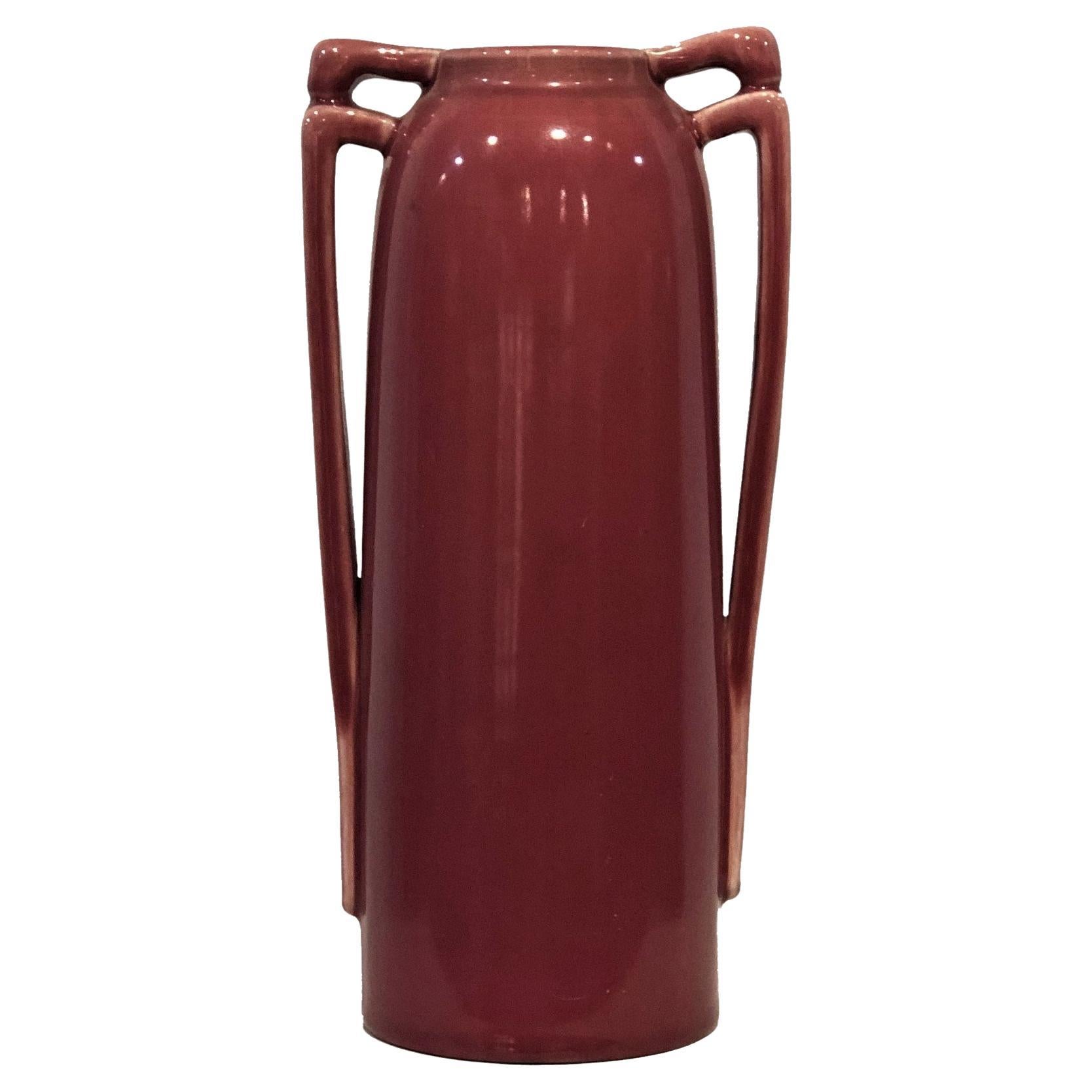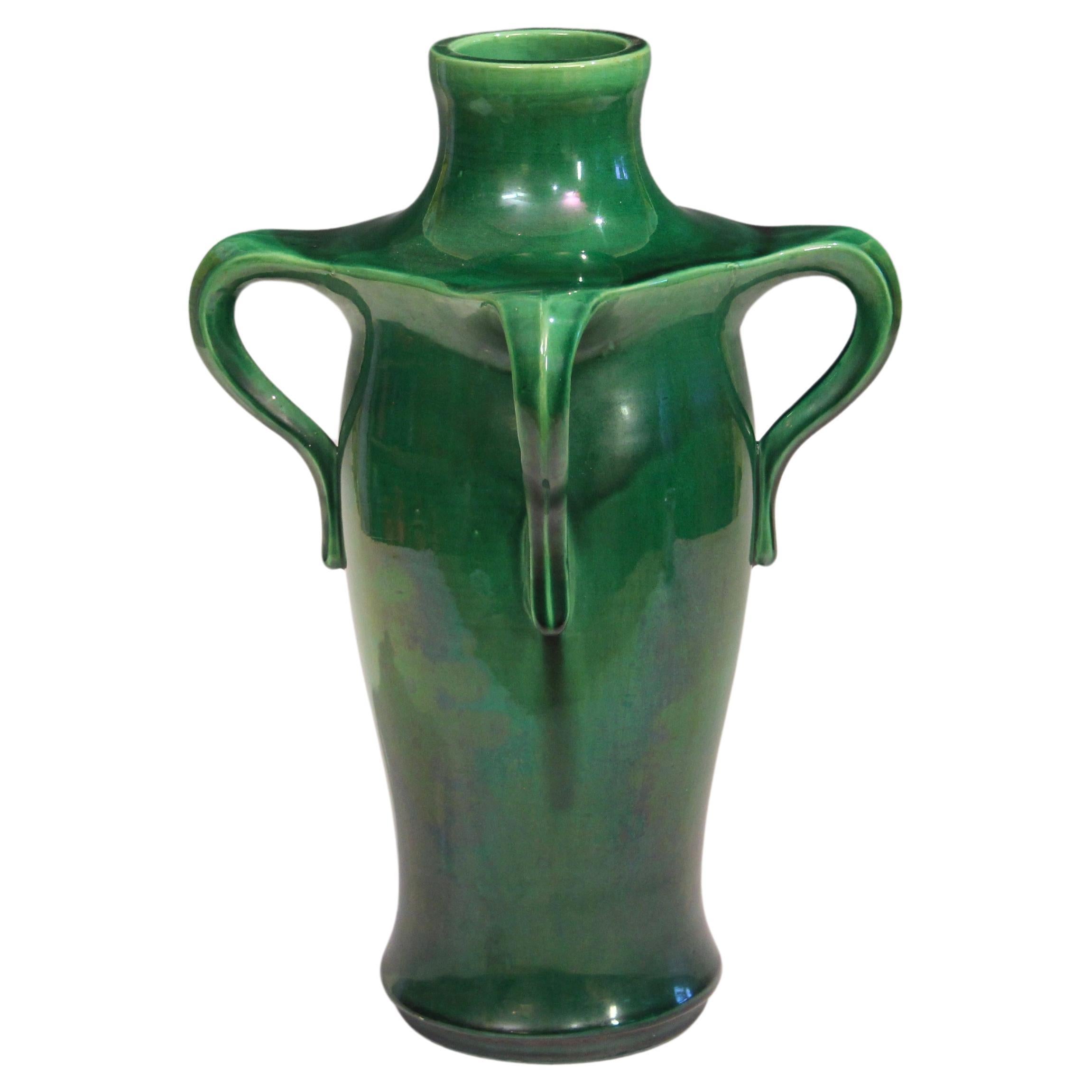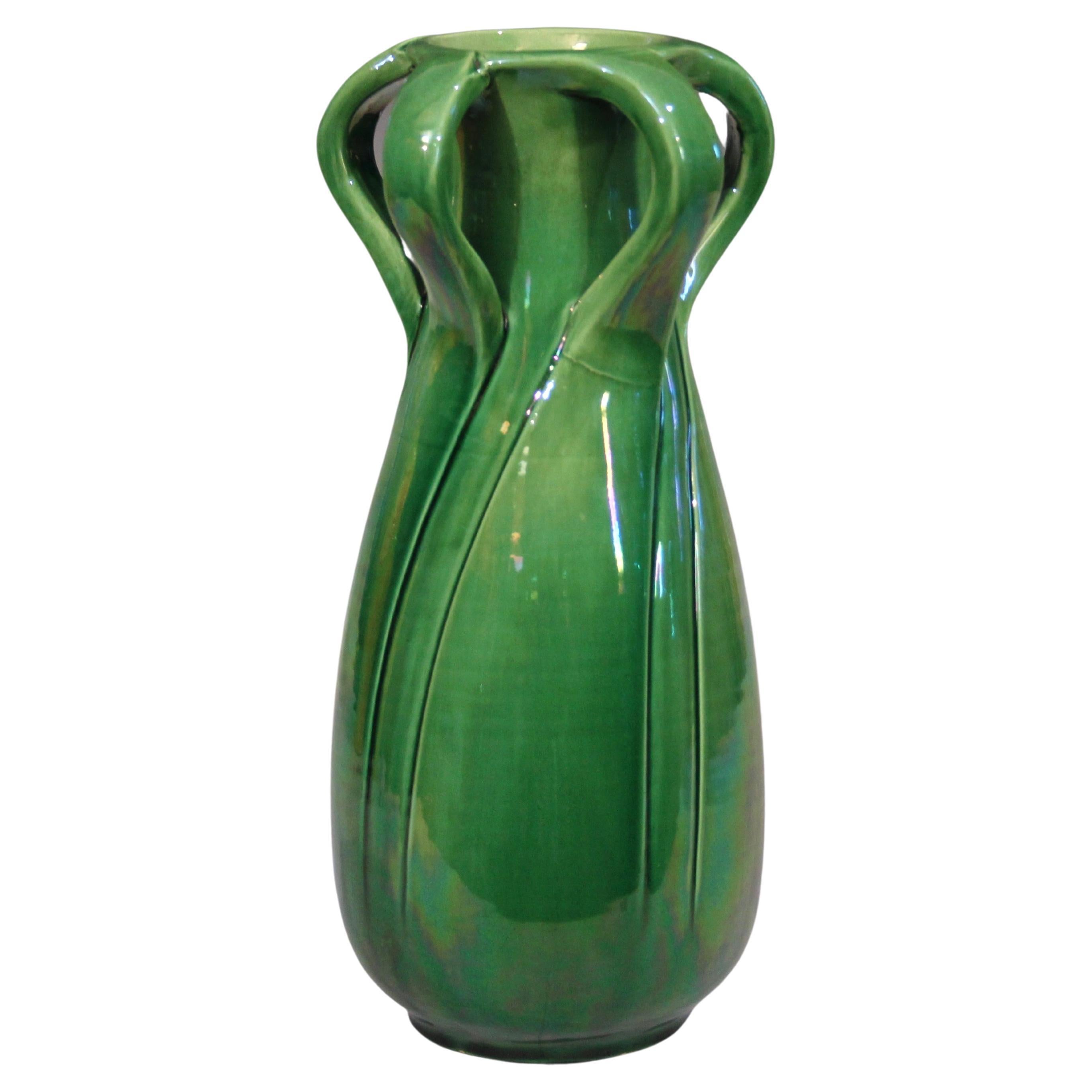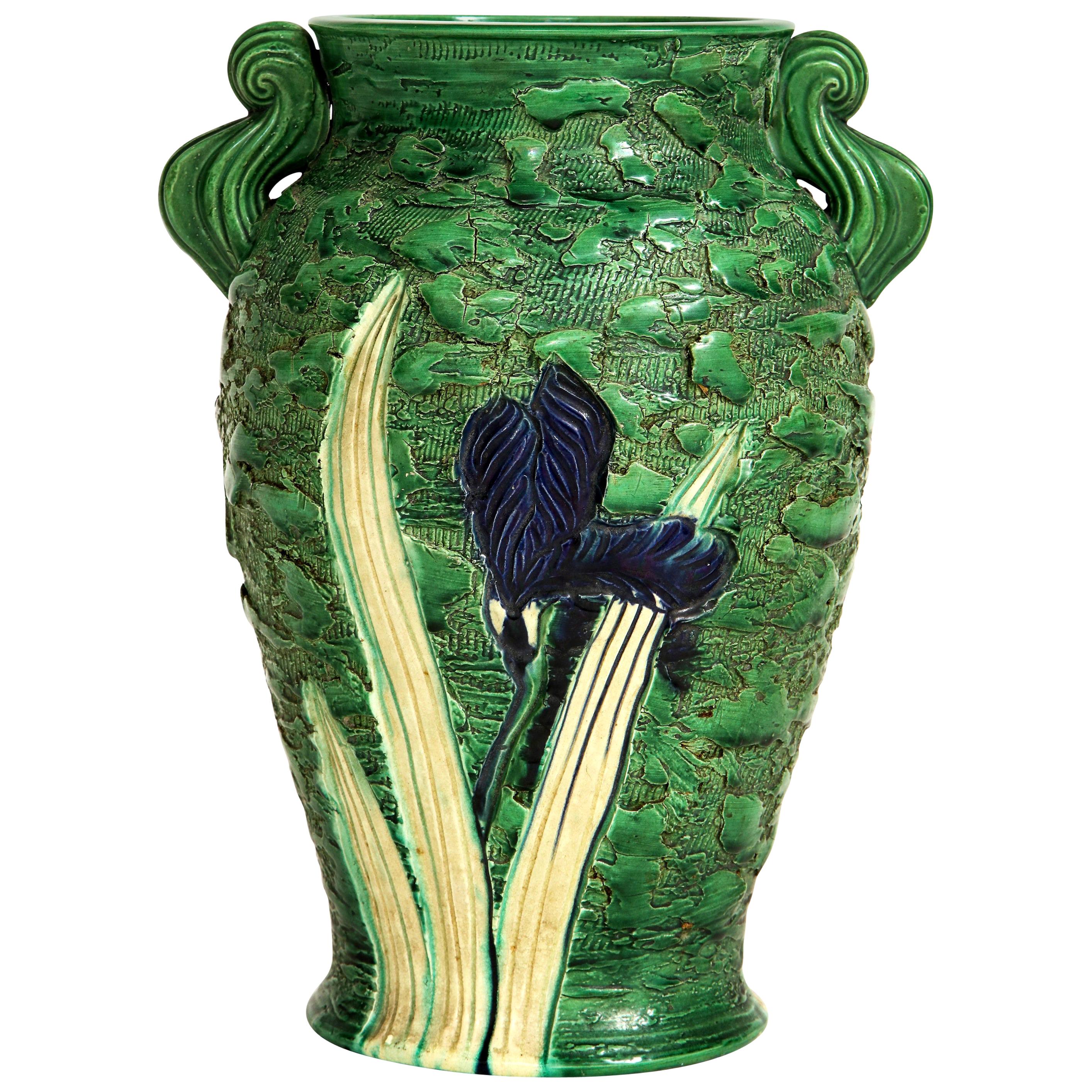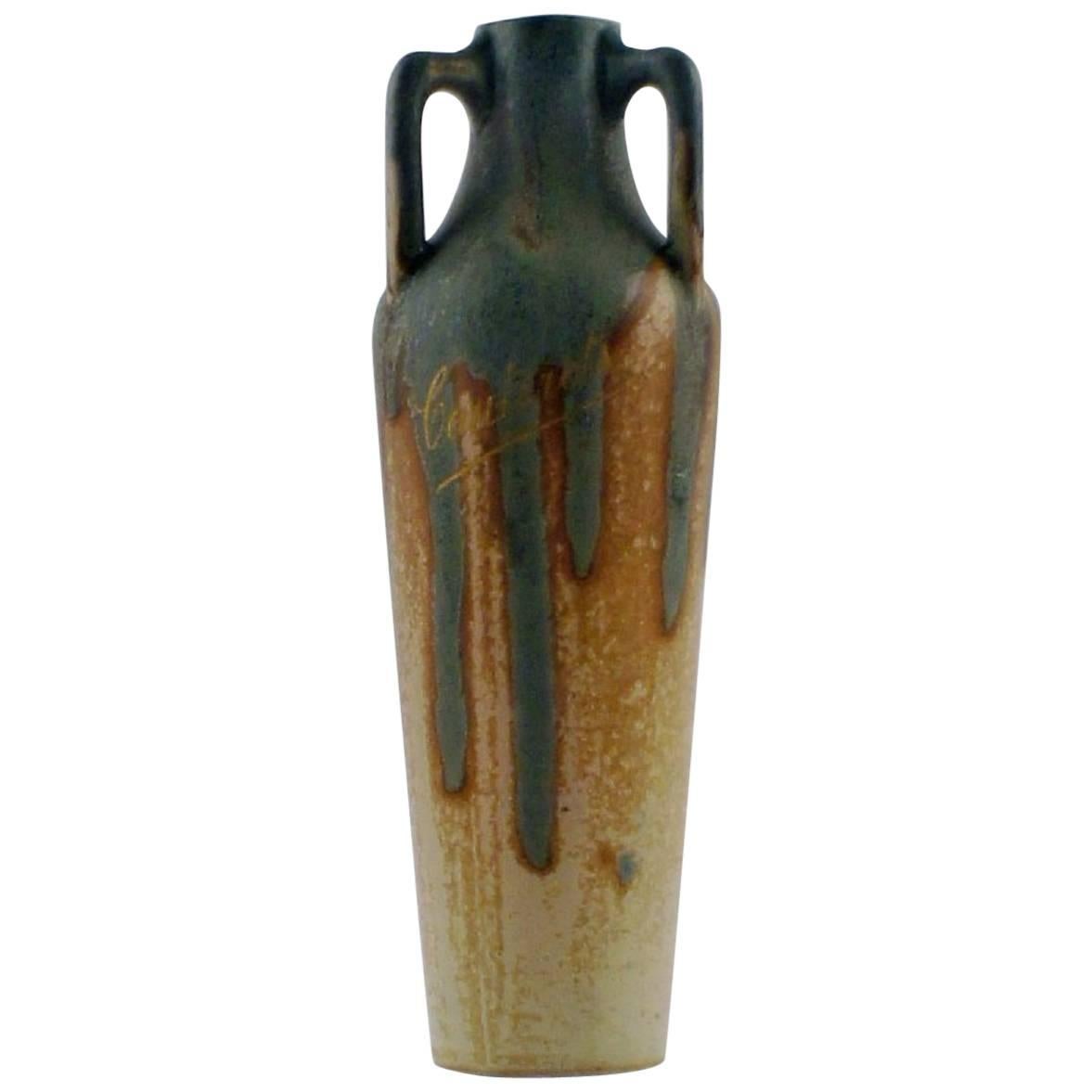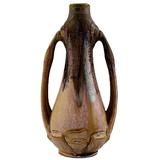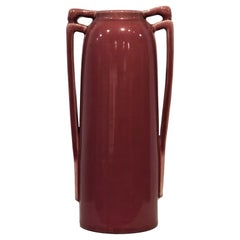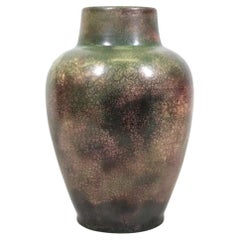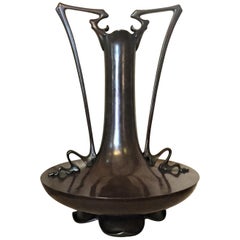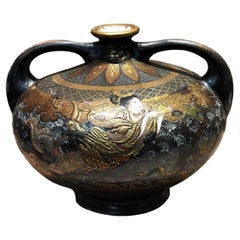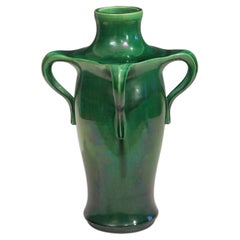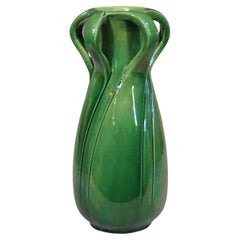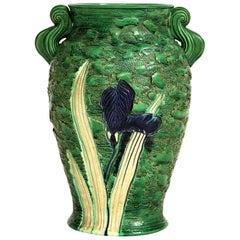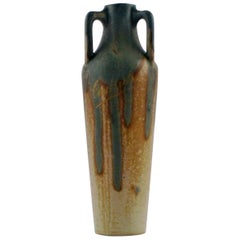Items Similar to Japanese Art Nouveau, Awaji Ware Art Studio Pottery Flower Vase, Ca. 1900
Want more images or videos?
Request additional images or videos from the seller
1 of 9
Japanese Art Nouveau, Awaji Ware Art Studio Pottery Flower Vase, Ca. 1900
$2,200
£1,662.93
€1,911
CA$3,063.49
A$3,408
CHF 1,786.52
MX$41,644.97
NOK 22,749.08
SEK 21,415.11
DKK 14,264.88
Shipping
Retrieving quote...The 1stDibs Promise:
Authenticity Guarantee,
Money-Back Guarantee,
24-Hour Cancellation
About the Item
DIMENSIONS:
Height: 12.5 inches
Width: 6.75 inches
Depth: 6.75 inches
ABOUT AWAJI POTTERY
Awaji pottery was made on the Japanese island of the same name between 1830 and 1939. Most of the pieces that we see here in the West were made sometime between the mid 1870's when Awaji began exporting pottery, and the mid to late 1930's when the last of the kilns closed. Awaji pottery comes in an abundant variety of shapes, colors, and decorative techniques. The glazes are often brilliant in tone and most are translucent and finely crackled. The ware is sometimes mistaken by the uninitiated for European majolica or American art pottery. Unlike majolica and the vast majority of Western art pottery, most Awaji pottery is robustly hand-thrown, with only small and complex forms molded. Some of the earlier ware is delicately potted, but the majority of Awaji-ware is more stoutly constructed and pleasantly balanced. The Awaji potters were masters of their craft who had an innate feel for the possibilities of the clay form. The result of their efforts is a pottery of exceptionally lively forms that have an informal and genuine feel, devoid of fussiness and pretension.
The ceramic body (or paste) is made of high-fired, white or cream colored clay that borders on stoneware. The formula apparently changed over time and varied from pink or buff, to white to grey. The glazes are lead based which gives the colors brilliance and makes the translucent enamels glassy and often iridescent. The most common Awaji glaze colors are a grass green, yellow that can range from pale lemon to deep amber, cobalt blue, and aubergine. Other glazes are a light green, dusty blue, light and dark turquoise, mirror-black, and burgundy. The Awaji potters were adept at creating unadorned monochromes, two-tone glazes, three-color glazes (sancai), incised decoration (most commonly featuring irises), and applied relief decoration.
ABOUT AWAJI ISLAND
Awaji is an island in Japan’s inland sea between Honshu, the largest of Japan’s four main islands, and Shikoku, which is the smallest. The island is known for its beautiful scenery and quaint fishing villages which have attracted artists seeking retreat and inspiration for centuries. There is a renowned puppet theatre, ningyo joruri, which performs traditional dramas on the island which has traveled internationally. The narrow channel between Awaji and Shikoku is the site of the dramatic Naruto whirlpools featured in Japanese legend, which are caused by the tidal flow in and out of the inland sea. Awaji is now connected to Honshu by the Kobe-Awaji Bridge, which is the longest suspension bridge in the world.
ABOUT AWAJI KILNS
The first kiln on Awaji was started in 1831 by a doctor named Minpei in the village of Iga. Minpei was an energetic man of some means with wide ranging interests. He is known to have been a doctor, a talented writer, a renowned chajin (tea ceremony master), a soy sauce factory owner, and run a large fishing cooperative before devoting all of his energies to ceramic manufacture. In 1834, Ogata Shuhei, a highly esteemed Kyoto potter, came to work with Minpei for two years. A wide variety of fine wares were made in the fifty years which followed. The kiln was known for fine Satsuma-type pieces in the Kyoto or Awata style with elaborately glazed geometric designs and aptly executed foliage and wildlife. Minpei also mastered underglaze-blue decoration, carved celadons, ceramics that cleverly imitated bronze vessels, and bright yellow and green monochromes with incised designs. In 1842, the provincial Daimyo, or Governor, came to visit the operation and granted Minpei an official kiln status. Minpei retired in 1862, leaving the kiln to his son Rikita and nephew Sanpei.
By the 1870's, Rikita and Sanpei were each running kilns of their own and exhibiting in the International Exhibitions, where their wares were well received. In the late 1870's, Christopher Dresser, the influential British designer, visited the two kilns and ordered examples of each to be shipped back to England for study. In 1883, Rikita sold his works to a group that called the kiln Danto—which means “Group” in Japanese. Though Sanpei did not begin production at his own kiln until about 1870, his operation quickly became the larger of the two. A third kiln was set up in Awaji's capital, Sumoto, in 1883 by Tamura Kyuhei.
Some of the artists in Awaji evidently maintained a relationship with their counterparts in Kyoto. Pieces from each region continued to share similar raw materials and processes as well as nearly identical forms, glazes, and decorative techniques. They each used cream colored pottery clay with brilliant enamel glazes, fired to approximately the same temperature. Each used the point bottle form and the popular squared buttress handle form.
Through the 1880's and 90's, the Danto and Sanpei kilns, evidently influenced by their clients in the West, began to shift their styles. As the export market developed Awaji pottery evolved from a distinctive regional style intended for domestic consumption to a pottery influenced by international tastes and markets. Despite this influence from outside pressures, the Awaji pottery retained its unique regional flavor. The forms became simpler and more organic; the decoration parsed to a spare and bold, but still spontaneously confident manner. Bright green, yellow, and blue glaze grounds were used both as monochromes to show off the forms, or as grounds under carved, incised and applied decorations highlighted with other blending and contrasting colors.
The Awaji potters were obviously aware of the International art movements of the late 19th and early 20th centuries. In response to the Art Nouveau style they used sensuous, organic, forms with sweeping curves and handles. These forms were accented by two tone glazes which melted into one another with hypnotic effect. These forms gave way to the boldly geometric style of the Art Deco movement. These are characterized by architecturally squared buttress handles and feet, along with rocket and other space-age forms. The Deco then gave way to the Modern Movement. The pieces made during this last long movement are some of the most interesting of the Awaji output.
During this final period (1922 - 1939), Sanpei's kiln produced an impressive array of extremely creative art pottery. A number of new glazes were developed, many of which are now used in striking flambé mixes. The two kilns closed in 1939 as the export market dropped off preceding World War II.
- Creator:Awaji Pottery (Maker)
- Dimensions:Height: 12.5 in (31.75 cm)Width: 6.75 in (17.15 cm)Depth: 6.75 in (17.15 cm)
- Style:Art Nouveau (Of the Period)
- Materials and Techniques:
- Place of Origin:
- Period:1900-1909
- Date of Manufacture:circa 1900
- Condition:Wear consistent with age and use. We make our best effort to provide a fair and descriptive condition report. Please examine photos attentively, as they are an integral part of the description. Send us a message to request more details or discuss price.
- Seller Location:New York, NY
- Reference Number:1stDibs: LU2819330230252
About the Seller
5.0
Vetted Professional Seller
Every seller passes strict standards for authenticity and reliability
Established in 1993
1stDibs seller since 2017
83 sales on 1stDibs
Typical response time: 7 hours
- ShippingRetrieving quote...Shipping from: New York, NY
- Return Policy
Authenticity Guarantee
In the unlikely event there’s an issue with an item’s authenticity, contact us within 1 year for a full refund. DetailsMoney-Back Guarantee
If your item is not as described, is damaged in transit, or does not arrive, contact us within 7 days for a full refund. Details24-Hour Cancellation
You have a 24-hour grace period in which to reconsider your purchase, with no questions asked.Vetted Professional Sellers
Our world-class sellers must adhere to strict standards for service and quality, maintaining the integrity of our listings.Price-Match Guarantee
If you find that a seller listed the same item for a lower price elsewhere, we’ll match it.Trusted Global Delivery
Our best-in-class carrier network provides specialized shipping options worldwide, including custom delivery.More From This Seller
View AllJapanese Art Nouveau Awaji Ware Art Studio Pottery Flower Vase, ca. 1900s
Located in New York, NY
Japanese Art Nouveau
Flower Vase
Awaji Ware Art Studio Pottery
ca. 1900s
ABOUT AWAJI WARE ART STUDIO POTTERY
Awaji pottery was made on the Japanese island of the same name between...
Category
Antique Early 1900s Japanese Art Nouveau Vases
Materials
Pottery
Arts & Crafts Chinese-Form Ceramic Vase, ca. 1900
By Roseville Pottery
Located in New York, NY
American Arts & Crafts
Chinese-Form Pauleo Pattern Glazed Ceramic Vase
In Manner of Roseville for Tiffany
Circa 1900
DIMENSIONS
Height: 15.75 inches (40.01 cm)
Diameter: 10.5 inch...
Category
Antique Early 1900s American Art Nouveau Vases
Materials
Ceramic
Japanese Art Nouveau Meiji Period Patinated Bronze Vase, circa 1900
Located in New York, NY
Although unmarked, this rare and important, grand but at the same exquisite patinated bronze vase has just a very few little details, defying the shape of the handles, as well as the...
Category
Antique Early 1900s Japanese Art Nouveau Vases
Materials
Bronze
Japanese Kyoto Fuzan Satsuma Ware Double-Handled Vase, Meiji Period, ca. 1900
Located in New York, NY
This beautiful end of Meiji Period Japanese Kyoto Fuzan Satsuma Ware double-handled vase has a gold plated intricate infinite circular relief pattern design and two images of goddess...
Category
Antique Early 1900s Japanese Taisho Vases
Materials
Porcelain
Japanese Emperor Shōwa Period Kiyomizu-Ware Vase, 18th Century
Located in New York, NY
Japanese Emperor Shōwa Period Kiyomizu-Ware Vase, 18th Century
Emperor Shōwa Period - from 1926 to 1989/1990
DIMENSIONS
Height: 9 inches
diame...
Category
Antique 1770s Japanese Japonisme Vases
Materials
Ceramic
Alfonso Canciani, Viennese Secession Orientalist Bronze Vase, c. 1910
By Alfonso Canciani
Located in New York, NY
Alfonso Canciani (Italian-Austrian, 1863-1955) was a famous Italian-Austrian sculptor of the period of accession to the Viennese Secession. Son of a stonemason, after a realist period he managed to establish himself as a leading sculptor of the Viennese Secession. In fact, he worked in Vienna, where he had enrolled in 1886 at the Academy of Fine Arts, then at the Higher School of Sculpture and finally at the Special School, where he obtained the Rome prize for the sketch for Dante's Monument.
He developed a notable business obtaining important prizes and numerous commissions. First among the sculptors of the Viennese capital, he was invited to join the Association of the Viennese Secession, of which Klimt was magna pars, after the exhibition of Dante's group in 1900 at the Secession exhibition, and obtained the most important Austrian artistic prize, the Kunstlerlpreis.
This same work, presented in 1910 in Berlin, at the Great Art Exhibition, also received an important recognition here. He obtained the Rome prize in 1896, exhibited successfully in Munich and in 1899 at the III International Art Exhibition in Venice.
In that period he made some statues of saints for the cathedral of Santo Stefano in Vienna, the monument to Wagner, the bust of Nietzsche for the University, the scepter and the gold chain of the University Rector, figures of Italian poets ( Petrarch, Boccaccio, Tasso, Ariosto).
He submitted a sketch for the official monument to Empress Elizabeth, which was then built in Austrisn Gföhl and Pula. At the time of his accession to the Secession, he dedicated himself to decorating the facade of the Artaria house in Vienna in collaboration with the architect Max Fabiani.
He later abandoned the symbolist decorativism of the Jugendstil for a more concentrated and vigorous style, approaching the Belgian sculptor Constantin Meunier for the theme of work, and preferring to exhibit at the Künstlerhaus.
In Vienna, he was generous with advice and help with the Italians and in particular with his fellow citizens (such as the Brazzanese Luigi Visintin, then a university student).
After the First World War, he returned to Italy and lived in Friuli, penalized by the fact that the Habsburg Empire had by now disappeared. Instead of large-scale public monuments, he then devoted himself to engraving medals (e.g. for Benedict XV and for the Italian mission in Vienna in 1919) and to designing funeral monuments (examples in Mali Lošinj and Trieste) and portrait busts (of Generals Carlo Caneva and Antonio Baldissera in Udine, sculptures of the War Memorial of Corno di Rosazzo). After all, he had already executed the Bab grave monument in the Döblinger cemetery in Vienna in 1909.
He taught in Trieste from 1920 until 1935, at the local school of industrial art, where he had Marcello Mascherini...
Category
Vintage 1910s Austrian Jugendstil Vases
Materials
Bronze
You May Also Like
Antique Awaji Pottery Art Nouveau Four Handle Green Vase
By Awaji Pottery
Located in Wilton, CT
Antique Awaji pottery Art Nouveau form vase with four willowy handles emanating from a squared shoulder in deep green glaze, circa 1910. Measures: 14 1/2" high, 7 1/2" diameter. Dri...
Category
Vintage 1910s Japanese Arts and Crafts Vases
Materials
Pottery
Antique Awaji Pottery Arts & Crafts Green Organic Nouveau Monochrome Vase
By Awaji Pottery
Located in Wilton, CT
Antique Awaji pottery vase in terrific swirled petal form in green monochrome glaze. Measures: 11 1/2" high, 5" diameter. Unmarked. Excellent condition.
Category
Vintage 1910s Japanese Art Nouveau Vases
Materials
Pottery
Awaji Pottery Vase, circa 1920s
By Awaji Pottery
Located in New York, NY
Stunning and large emerald green hand card ceramic Awaji vase with iris design. This dynamic vase shows the artistry of the Japanese during the 1920s. Magnificent scale and a vibrant...
Category
Vintage 1920s Japanese Vases
Materials
Pottery
French Ceramic Vase, Cauterets, Conical Vase, France, circa 1910
Located in København, Copenhagen
French ceramic vase, Cauterets.
Signed. Conical vase, blue-gray glaze running on beige-brown ground, France, circa 1910.
Heights: 17 cm.
In perfect c...
Category
Vintage 1910s French Art Nouveau Vases
$352 Sale Price
20% Off
French Art Nouveau Ceramic Vase, Denbac Produced in Vierzon
Located in København, Copenhagen
French Art Nouveau ceramic vase, Denbac (1909-1952) produced in Vierzon,
circa 1920s.
Signed.
Beautiful polychrome glaze.
Measures: 23 cm. x 12 cm.
In perfect condition.
Category
Vintage 1920s French Art Nouveau Vases
$512 Sale Price
20% Off
Glazed Ceramic Vase Stamped Denbac, 1940's
Located in Beirut, LB
This vase is a handcrafted ceramic piece featuring a dark glaze with a slightly textured, organic finish. Its elegant, elongated form is accentuated by two small looped handles near ...
Category
Mid-20th Century French Art Nouveau Vases
Materials
Ceramic
More Ways To Browse
Japan 1900
Large Blue Pottery
Japan Ware
Relief Pottery
Antique Bedroom Sets 1900
Ceramic Pottery Blue White
Small Art Pottery Vase
Yellow Pottery Vase
Applied Flowers Vase
Small Japanese Vases
Blue Yellow Pottery
Black Japanese Pottery
Art Deco Pottery Vases
Pink Pottery
Japanese Clay Vase
Turquoise Pottery
Antique Pottery Names
Green Ware
